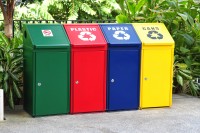Greenwood School 8th grader Leyla Spositto and her classmates knew something was amiss just a few weeks into the school year when they saw the trash piling up.
Greenwood administrators had chosen San Ramon, Calif.-based Choicelunch as the school’s new lunch provider largely because nearly all of its packaging was made of compostable materials – from corn-based bio-plastic cups to potato-based “spudware” forks and spoons – and therefore would be diverted from the landfill. The move fit with one of the school’s core values of environmental stewardship.
But when Greenwood environmental science teacher Julie Hanft told the students that so-called bio-plastics weren’t being composted in Marin, Greenwood’s 7th and 8th graders, who handle the school’s trash as part of their after-school chores, were stunned.
“All of the stuff from Choicelunch was going to the trash,” Spositto said. “We were very surprised that a system didn’t exist for the packaging to be composted like it was supposed to be.”
So was Greenwood School Director Debra Lambrecht.
“We were very, very surprised,” Lambrecht said. “And the fact that the children were shocked and appalled? We thought, ‘Well right on.’”
With lots of packaging that could neither be composted nor recycled – bio-plastics can’t be recycled like regular plastic – the students and Hanft arranged to have a large collection of their Choicelunch packaging taken to Recology near Candlestick Park in San Francisco, where bio-plastics are composted. But they quickly realized that having a parent or teacher drive a truck across the Golden Gate Bridge weekly wasn’t exactly a sustainable solution.
Greenwood’s students and school administrators found themselves at the crossroads of an issue that all involved say is riddled with complexities. As a result, many Marin residents who think they’re making eco-friendly decisions – buying only compostable plastic cups for their children’s birthday party, for example – are sending more garbage to the landfill than if they were using recyclable materials.
“That’s the big shame about bio-plastics – people think they’re doing the right thing,” said Jessica Jones, the district manager for Redwood Landfill and Recycling Center in Novato, where most of the trash, recycling and compost from northern and southern Marin is taken.
Jones said Redwood, a subsidiary of Waste Management Inc., doesn’t compost bio-plastics because the compost the company produces is sold to and used on organic farms. If its compost contained any materials that took longer to biodegrade – like corn-based foodware or bio bags, for instance – it could not be certified by the Organic Materials Review Institute, the Eugene, Ore., which provides independent review of products to be used in organic farming.
Jim Iavarone, managing director at Mill Valley Refuse, which sends all of its waste to Redwood, said the inability to compost bio-plastics “has been a continual issue for us” ever since the company rolled out compost service in August 2010.
“The makers of these products and food services (like ChoiceLunch) have hung their hat on that,” Iavarone said. “It’s a good idea that just isn’t delivering as hoped or as advertised.”
Devi Peri, the education coordinator for Marin Sanitary Service, which serves most of Central Marin, including San Rafael, Larspur, Corte Madera, San Anselmo, Fairfax and the Ross Valley and Las Gallinas sanitary districts, says her company is in the same boat as Redwood.
“Not all compostable plastics are created equal and we don’t even have any way to see if it’s a true biodegradable plastic,” she said.
But compostable bio-plastics are accepted by other Bay Area waste companies like Recology, which processes most of its OMRI-certified compost at Jepson Prairie Organics, a facility in Vacaville.
“There is a clear disconnect between how Recology can compost bio-plastics and how we can’t,” Jones said.
The difference, according to OMRO Program Director Lindsay Fernandez-Salvador, is that Recology has an extensive “foreign removal program.” That program, essentially a filtering system, calls for manual removal of any all bio-plastic products not clearly labeled compostable. Under California law, products labeled compostable must meet the Biodegradable Products Institute’s ASTM D6400 standards, which “determine if plastics and products made from plastics will compost satisfactorily, including biodegrading at a rate comparable to known compostable materials.”
“Any compost may become contaminated with compostable plastics, but if the program has a reasonably robust foreign removal program, that satisfies OMRI’s requirements,” Fernandez-Salvador said.
A foreign removal program means that bio-plastics that aren’t labeled clearly or don’t meet the standards either end up in a separate compost stream of only products that will degrade at a slower rate than food scraps or yard waste – or they’re tossed into the landfill.
Peri said there is some industry skepticism about how much bio-plastic material is actually ending up in the compost streams at places like Recology.
“I have a feeling that it might be more (going to the landfill) than people might want to hear,” Peri said. “And maybe more than they are reporting.”
Jack Macy, the Zero Waste Coordinator for the city of San Francisco, acknowledged that some “compostable stuff that is not labeled well ends up in the landfill.”
“But the reason that we accept compostable bags and compostable foodware is that it allows us to capture more of the organics that we’re trying to divert from the landfill,” Macy added. “Every composter would prefer not to take that stuff because of the challenges of identification and the breaking down aspect. It’s easier to say no.”
That’s the choice Redwood has made, which spurred Greenwood’s 7th and 8th graders to take on the issue as a community action project. The students researched other options, spoke with potential vendors and made a presentation to Lambrecht right before the holiday break. The school intends to move to a completely independent lunch system next year, with an in-house chef making lunches dispensed with reusable plates and utensils. The move is one that only schools as small as Greenwood, with just 127 students, can afford to make.
In the meantime, Greenwood administrators have decided to dump Choicelunch and explore alternative options for the rest of this year.
“It is very disappointing,” said Karen Heller, the director of business development for Choicelunch, whose company supplies lunches for more than a dozen schools in Marin, including the Mill Valley and Ross Valley school districts. “But it hinges on the waste management company. Our hands are kind of tied.”
For two days a week, the school’s 8th graders will be selling lunch from Grilly’s and Tamalpie Pizzeria (one day apiece) to raise money for their 10-day spring trip. Lambrecht hopes to have a new deal in place in the coming days for the other days.
“We’ve really felt like we’ve accomplished something,” Spositto said of the student’s campaign. “We’re glad we had the authority to make this happen.”



